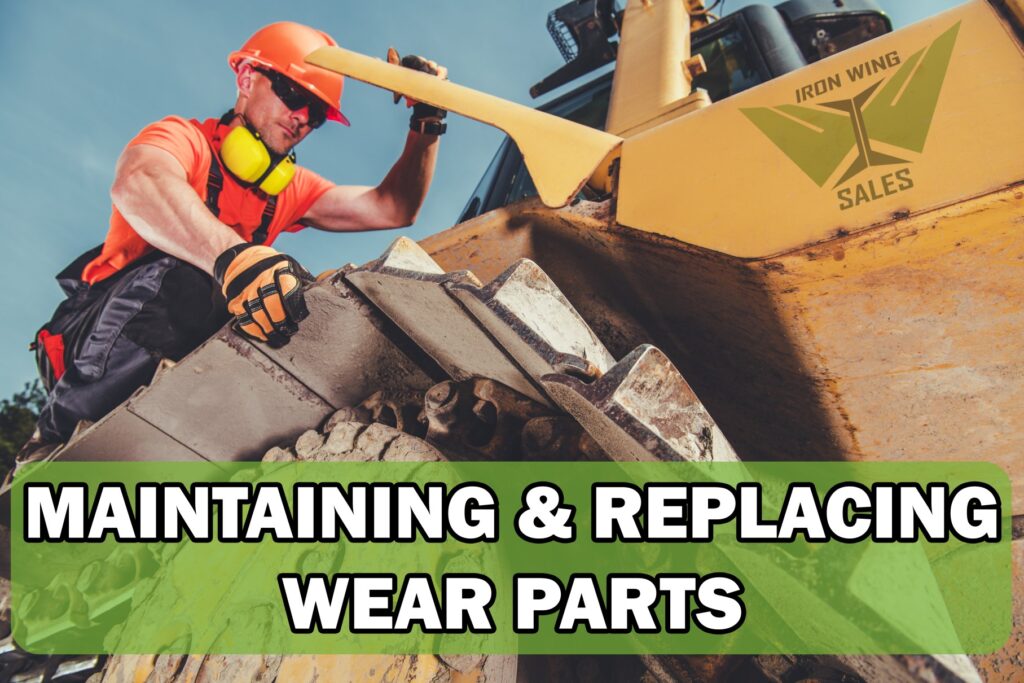
Heavy equipment is built to last, but even the most durable machines require regular maintenance and repairs to keep them running smoothly. One critical aspect of heavy equipment maintenance is the inspection and replacement of wear parts. These parts are designed to wear down over time and need to be replaced periodically to maintain optimal performance and prevent costly breakdowns. In this post, we’ll discuss the benefits of regularly inspecting and replacing your heavy equipment’s wear parts.
Benefits of Regular Maintenance
- Prevents Costly Downtime: Equipment downtime can be expensive, leading to lost productivity and revenue. Regularly inspecting and replacing wear parts can help prevent sudden breakdowns, which can cause costly downtime. By proactively replacing parts that are showing signs of wear, you can avoid unexpected breakdowns and keep your equipment running smoothly.
- Improves Equipment Performance: Worn-out parts can cause your equipment to function poorly, leading to decreased efficiency and increased fuel consumption. By replacing these parts regularly, you can ensure that your equipment is operating at peak performance, which can improve productivity and reduce operating costs.
- Increases Safety: Worn-out parts can be dangerous, increasing the risk of accidents and injuries. Regular inspections can help identify parts that need to be replaced, reducing the risk of accidents and improving safety for your workers.
- Extends Equipment Lifespan: Regular inspections and replacements can help extend the lifespan of your heavy equipment. By replacing worn-out parts before they cause damage to other components, you can prevent more significant problems down the road and extend the life of your equipment.
- Saves Money in the Long Run: Although regularly inspecting and replacing wear parts may seem like an added expense, it can save you money in the long run. By preventing breakdowns, improving efficiency, and extending the life of your equipment, you can reduce repair and replacement costs and improve your bottom line.
Wear Parts to Maintain
Here are a few examples of wear parts to focus on when doing preventative maintenance:
- Filters: Filters are critical components in heavy equipment that help keep the engine and hydraulic systems clean and free of contaminants. Dirty or clogged filters can cause significant damage to these systems and reduce equipment performance.
- Belts and Hoses: Belts and hoses are used to transfer power and fluids throughout heavy equipment. Over time, they can become worn, cracked, or damaged, leading to decreased performance or even failure.
- Undercarriage: Undercarriage parts are some of the most critical wear parts on heavy equipment. They are exposed to harsh conditions such as uneven terrain, extreme temperatures, and heavy loads, which can cause them to wear down quickly. Worn tires, sprockets, track pads, idlers, rollers, springs, and other undercarriage parts can affect equipment performance and increase the risk of accidents.
- Brakes: Heavy equipment brakes are subject to significant wear and tear due to the weight and speed of the equipment. Regular inspections and replacements of brake pads, rotors, and drums can help ensure proper stopping power and prevent accidents.
- Engine Components: Parts such as starters, alternators, and fuel injectors help start an engine and keep it running smoothly and effectively. Monitoring engine performance and replacing parts as needed can help ensure reliable and powerful engine performance.
- Attachments: Bucket teeth, cutting edges, cutter bits, dozer blades, roll bars, wear blocks, wear buttons, and other ground engaging tools (G.E.T.) frequently interface with the ground and other materials. As a result, these parts wear out through regular use. Replacement of G.E.T. can help maintain productivity while also protecting your equipment.
- Hydraulic Components: Hydraulic cylinders, hoses, and seals can wear down over time, causing leaks and reducing the effectiveness of the hydraulic system. Inspecting and replacing these components can prevent system failure and improve equipment performance.
- Fluids & Oils: Regularly checking and replacing engine oil, hydraulic fluid, and transmission fluid serves to maximize the efficiency of your machinery while also increasing the longevity. Replacing fluids helps to conserve the rest of your components, so it is essential to monitor fluids and regularly replace them.
These are just a few of the heavy equipment parts that should be routinely inspected, maintained, and replaced in order to prevent larger problems.
In conclusion, regularly inspecting and replacing your heavy equipment’s wear parts is essential to maintaining optimal performance, safety, and efficiency. By staying on top of wear part maintenance, you can prevent breakdowns, increase equipment lifespan, and save money in the long run. If you’re not already doing so, consider implementing a proactive wear part replacement program to keep your heavy equipment running smoothly.
Wear Parts at Iron Wing Sales
Looking to replace worn parts? At Iron Wing Sales, we have a large inventory of OEM and aftermarket heavy equipment parts in-stock and ready to ship! Simply browse by category, or you can use our search function to sort by description, part number, or manufacturer. We also offer free shipping on qualifying orders >$100. Additional inquiries, contact us by email: sales@ironwingsales.com or by phone: (216) 912-9089

